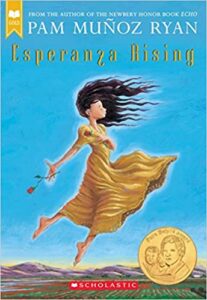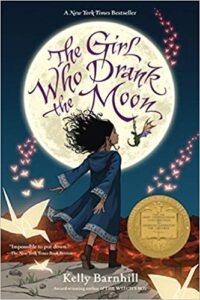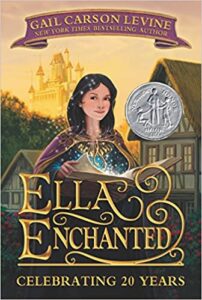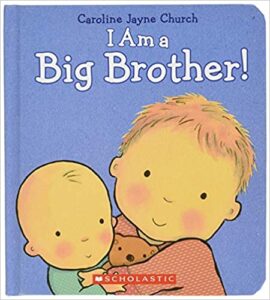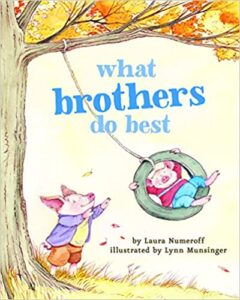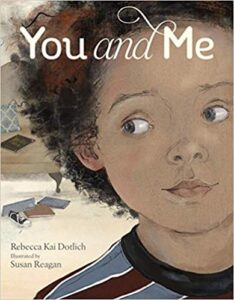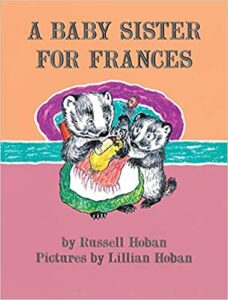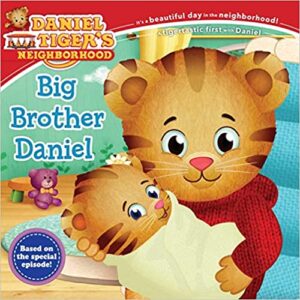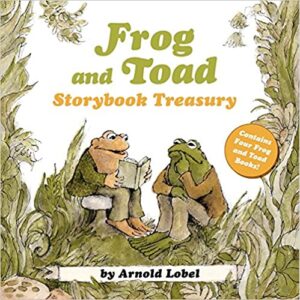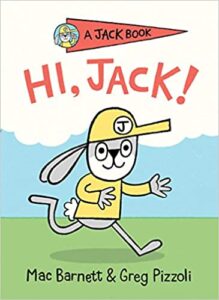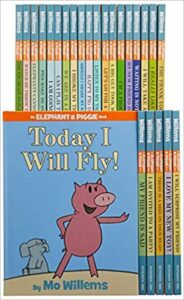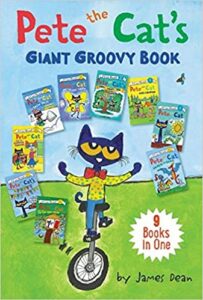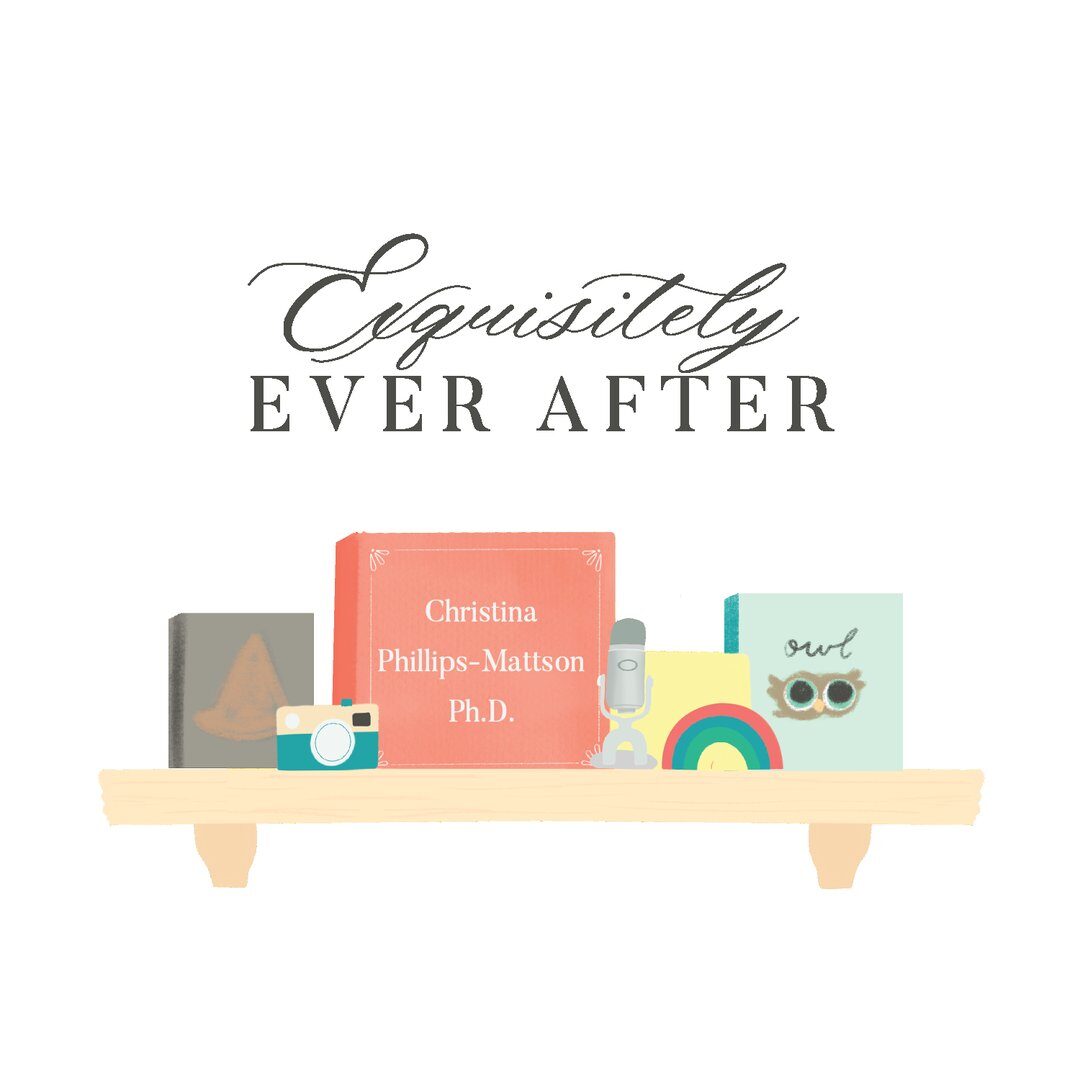
Some links are affiliate links. Please see more here.
SUMMARY: In this special final episode of Season 2, I answer YOUR questions about children’s literature and reading to children. We cover topics such as the importance of reading in the Early Years; what books will hook an 9-year-old reader; how to prepare a child for the arrival of a new baby; and how to teach your child to read using early reader books. Happy Reading and I’m looking forward to talking to you in Season 3!
Listen to the Podcast Episode:
Books Mentioned in this Episode:
*Esperanza Rising by Pam Muñoz Ryan
*The Girl Who Drank the Moon by Kelly Barnhill
*Ella Enchanted by Gail Carson Levine
The Enchanted Collection by Gail Carson Levine
*I Am A Big Brother by Caroline Jayne Church
*What Brothers Do Best by Laura Numeroff and illustrated by Lynn Munsinger
*You and Me by Rebecca Kai Dotlich and illustrated by Susan Reagan
*A Baby Sister for Frances by Russell Hoban and Lillian Hoban
Bedtime for Frances by Russell Hoban and Lillian Hoban
Best Friends for Frances by Russell Hoban and Lillian Hoban
*Julius the Baby of the World by Kevin Henkes
*Big Brother Daniel by Angela C. Santomero and Jason Fructer
The Watermelon Seed by Greg Pizzoli
What a Wonderful World by Bob Thiel and George David Weiss, illustrated by Tim Hopgood
Little Blue Truck by Alice Schertle, illustrated by Jill McElmurry
The Little Fur Family by Margaret Wise Brown, illustrated by Garth Williams
Good Night Owl by Greg Pizzoli
Goodnight Moon by Margaret Wise Brown, illustrated by Clement Hurd
*Frog and Toad Storybook Treasury by Arnold Lobel
Owl At Home by Arnold Lobel
*The Jack Books by Mac Barnett and Greg Pizzoli
*Jack and Santa by Mac Barnett and Greg Pizzoli
*Hi, Jack! by Mac Barnett and Greg Pizzoli
*Jack at Bat by Mac Barnett and Greg Pizzoli
*Jack Blasts Off by Mac Barnett and Greg Pizzoli
Baloney and Friends by Greg Pizzoli
Baloney and Friends: Going Up! by Greg Pizzoli
*Elephant and Piggie Books by Mo Willems
*Elephants Cannot Dance by Mo Willems
*The Pete the Cat Books (various authors)
*Pete the Cat: I Love My White Shoes by Eric Litwin, illustrated by James Dean
*A Pet for Pete by Kimberly Dean, illustrated by James Dean
*Pete the Cat Goes Camping by Kimberly Dean, illustrated by James Dean
Television Shows and Apps Mentioned in this Episode:
Daniel Tiger’s Neighborhood: The Baby is Here
Daniel Tiger’s Neighborhood: The Tiger Family Grows/ Daniel Learns About Being A Big Brother
Daniel Tiger’s Neighborhood: Time for Daniel/There’s Time for Daniel and Baby Too
Daniel Tiger’s Neighborhood: Playtime is Different/ The Playground is Different With Baby
Podcast Transcript:
Hello Everybody! Welcome to our special 20th Ask Me Anything Episode of the Exquisitely Ever After Podcast. Thank you so much for submitting all of your questions! I received a bunch of them so in this episode I’m going to limit myself to answering three for the sake of time, but I will definitely do another one of these episodes in the upcoming seasons, so if I don’t get to your question today, I will be sure to answer it in the future on the podcast and, in the meantime, I’ll email you or dm you back with an abbreviated answer to tide you over! Also, when I put out the call for questions, I forgot to ask if I could use your real names, so for the sake of everyone’s privacy, I’m going to keep the person’s identity anonymous in this episode. But for future reference, if you submit a question, I’d love to use your name. So, anyway, let’s dive in!
Here is the first question:
Hi Christina! I’m curious about why you started this podcast and also, would you consider talking more about books for older readers? I am really enjoying the content for my two younger kids (ages 5 ½ and 3), but would love more book recs for my 8 almost 9-year-old daughter. She’s not super into reading anymore and I’d like something that’s not too advanced but not super easy, will hook her attention, and has a female protagonist. Bonus points for a BIPOC lead or a princess. Hope this isn’t too specific! (and she put the little yikes face emoji with the gritted teeth) Thanks!
So first off, thanks for your questions and I’m so glad you’re enjoying the podcast! The answers to your first two questions are related to each other so: Yes! I would love to recommend more books for older children and actually, I started my career and wrote my dissertation focusing more on books for older elementary and young adult readers. But there are two reasons why I decided to start the podcast by focusing on books for kids in the 0 to around 5-year-old range, or basically for children in what is called the “Early Years Sector” and they are:
FIRST: I am a parent of two children under 5 so basically, currently, I eat, sleep, and breathe board books and picture books. So things like, for example, choosing books to read that help build empathy in small children, and which books are best to teach your child about colors, and why it’s so important to read books to your newborn that stimulate their developing vision—all of these things are really fresh in my mind right now because I’m in the thick of early parenting.
But the SECOND reason is: (and this relates to why I started the podcast to begin with) I am really interested in the Early Years because it’s such a crucial time in a child’s development and reading books to children of this age group can have such a massive impact on the rest of their lives. Research that tells us that 90% of a child’s brain growth occurs in the first 5 years of life. That’s incredible when you think about it. The synapses (or the connections) that make the brain work are made at their fastest rate in early childhood (I think it’s something like one million new neural connections every second). And research has also shown that children’s everyday experiences in these early years, primarily experiences with their parents and caregivers, directly affect how the brain develops. The amount and the quality of attention and care, but also stimulation and interaction, that children receive in early childhood directly determines which synapses develop and last for that child’s lifetime. So a young child’s experiences, whether they are positive experiences or negative experiences, have a long-term impact on a child’s health and a child’s ability to learn and, therefore, tp succeed, not just in school but in life.
And that’s where reading comes in. Research shows that reading and child-directed speech are the best ways to optimize a child’s language skills early and create the best environment for their brains to grow in. Reading really is the key to your child’s success. So it’s incredibly crucial that we read to our children and I think that a lot of parents and caregivers either: know that reading is a good thing to do, but aren’t really aware that reading to your child is really one of the absolute best things you can do for your child’s future success, OR they know that reading is crucial, but they aren’t sure where and how to begin and what books to choose to optimize their read-aloud time.
So that’s why I created this podcast and website and some other resources on reading children’s literature that are coming soon in 2021 and that I can’t wait to tell you about as soon as I can. But, anyway, I figured that a podcast, unlike a book or a course, is free and accessible to, really, almost everyone AND it’s the ideal medium for busy parents because you can multitask while listening. I mean, for example, a mom with 3 kids who works full-time might not have the time or the resources or, you know, just the energy to buy and read a 200 or 300-page book on reading to young children, but she can listen to a podcast on her way to work or while she’s folding the laundry or mowing the lawn or something. My ultimate goal is to disseminate all the knowledge I have on this subject to as many parents and caregivers as possible, and thus, hopefully, impact as many children as possible. So, that’s why I started the podcast and I hope that answers your first couple of questions.
As for some books for your almost 9-year-old daughter, I have a few great ones: The first is one with a female protagonist who is a person of color and it’s called Esperanza Rising by Pam Muñoz Ryan. It takes place during the Great Depression and it’s about a young Mexican girl who lives a pretty privileged existence in Mexico until tragedy strikes and she and her mother are forced to flee to California and settle in a Mexican farm labor camp. Esperanza and her mother have to find a way to survive the grueling work and financial struggles in their new life as well as overcome the racism that they experience. It’s a beautiful, gripping story so I think it will really hook your daughter. But, one thing, I just want to make you aware that this book has some very, very sad parts to it, so even though the reading level probably won’t be too difficult, the subject matter is definitely difficult, so you might want to read it first and judge whether or not your daughter is ready for a story like this. In my experience, children can handle a lot more than we might think, but there are some very tough parts in this story, so I just want to be sensitive about that.
Okay! The next book I’d like to recommend is called The Girl Who Drank the Moon by Kelly Barnhill. Again, this book has female protagonists as you requested, but this time we’re in the fantasy literature genre. The story revolves around a witch named Xan and a girl named Luna who was one of the baby-sacrifices left in the forest by the people of what is known as the “Protectorate” to save them from the witch who they think will otherwise terrorize their town. But Xan, the witch, is actually kind and instead of murdering the children, she takes them through the forest, nourishing them with starlight on the journey, and delivers them to loving families on the other side. But one year, Xan accidentally feeds a baby moonlight instead of starlight, which fills the child with magic. She decides she must raise the child (whom she names Luna) herself. But then around Luna’s 13th birthday, dangerous things start to happen that make it imperative that Luna learn how to control her powers before it’s too late. This book won the Newbury Medal in 2017 and I think it was very well-deserved. The story is immersive and the characters are really compelling, so I think it’s a great choice for someone who wants that sensation of losing herself in a story.
The third book I want to recommend is one with a princess: It’s called Ella Enchanted, by Gail Carson Levine. This book is an older one, published in 1997, and it was actually one of my sister’s favorite books when she was a child, but I think it’s aged pretty well. It’s a retelling of the story of Cinderella. A child named Ella is cursed by a fairy named Lucinda who gives her what the fairy thinks is the “gift” of obedience, but which actually means that Ella has to do absolutely anything that anyone tells her to do. Despite these constraints, Ella isn’t a doormat—she uses her intelligence and her resourcefulness to rebel in whatever ways she can against the curse. When her beloved mother dies and Ella is left in the care of a pretty terrible father and, a bit later, an even more awful stepmother and treacherous stepsisters, Ella sets out of a journey to track down Lucinda to undo the curse and has many adventures on the way.
So, in this retelling there are many of the trappings of the traditional fairy tale, like the pumpkin coach, the prince, the glass slipper, and, of course, the happily ever after, but Ella isn’t a stereotypical damsel in distress. Rather, she’s a person and a heroine to be admired, someone who ultimately rescues others as well as rescues herself. And, bonus, if your daughter likes this book, Gail Carson Levine wrote other books with this same kind of classic-fairy-tale-but-with-a-twist premise, so even though it’s not a series, there are more, similar books for your daughter to read with more princesses in them. Oh! And I should mention there’s also a movie version of this book which I think is fun, but, as is almost always the case, the book is better.
Okay! Thank you again for your question! Here is the second question. This person writes:
Hi! Love the podcast, super helpful! (Aw, thank you!) I’m looking for suggestions for books about a kid becoming a big sibling. My son is 2.5 and I’m having another baby in a month. Thanks so much!
First of all, congratulations! That’s so exciting! Okay, I have a few recommendations. If you just want a straightforward, short, kid-becomes-a-big-sibling-and-needs-to-know-what-this-big-life-change-is-all-about book that you can read a bunch of times to get your son excited about the idea, there are three of this variety that I think are good. The first one is called I Am A Big Brother by Caroline Jayne Church. This one is a sweet, simple book that helps older children understand their new role in the family by showing all the things a big sibling can help with and do with the baby. What I like about this book is that it rhymes, it’s short, and the illustrations are super cute, so it’s appealing to younger children who are becoming siblings (like your 2.5-year-old) and it’s perfect for a quick read-aloud before naptime. And I also like that while it emphasizes the older sibling being helpful and caring and loving, it also makes it a point to emphasize the care and love that the parents still have for the older sibling, which is super important.
The second book of this type is called What Brothers Do Best by Laura Numeroff and illustrated by Lynn Munsinger. And, by the way, there’s also a What Sisters Do Best version of this book, too. This book shows a bunch of anthropomorphic big brother animals doing fun things with their little siblings, like a big brother pig who pushes a little brother pig on a swing and then shares a snack with him, and a big tiger brother who teaches his sister how to swim and does a puzzle with her, and a big panda brother who helps his young sibling clean his room and takes him to the library. And the book ends, “But best of all, brothers can give you lots and lots of love.” This one is such a cheerful, cozy book and the illustrations with the various animal siblings are really winsome and joyful. And some of them are funny in a cute way, like when the little panda sibling is stacking all of the library books and his big brother looks at him in a bemused sort of way. Again, I like this one because it’s short, it’s to the point, and emphasizes what fun a sibling relationship can be.
And the third book of this type is You and Me by Rebecca Kai Dotlich and illustrated by Susan Reagan. I already talked about this book in greater detail in one of my episodes on diverse books (it was Episode 10: Best Diverse Board Books for Babies and Toddlers) so if you want to hear more, you can go back and have a listen to that one, but I wanted to mention it again here because I think it would be a really good one for when your older child inevitably feels a little torn about his new situation and role in the family. It’s completely natural for a child to feel a sort of tug of war between being enamored with the new baby, but also missing and craving the undivided attention that he had pre-baby. So, it’s great to give your kids books like this so that they know that they aren’t alone or wrong in feeling this way and also to help them know that you understand that they might feel this way, that it’s okay, and that you still love them.
Okay, I have a couple more books that I want to recommend and these are more “literary,” traditional picture books. Both are really funny, relatable, and have great messages about the love and bond between siblings. I personally read both to my son James before we had Luke and if we have another child, I’ll definitely make sure that we read them to Luke during my pregnancy—well, really, to both of my boys because they’re both still in the target age range of these books—and we all love them.
The first is A Baby Sister for Frances by Russell Hoban and Lillian Hoban. So, we love the Frances books in my house. Bedtime for Frances is, in my opinion, just a masterpiece of a picture book and both of my children adore the badger Frances character. A Baby Sister for Frances is written in the same style as Bedtime for Frances with Frances’s funny little rhymes and songs peppering the text and her parents responding to her complaints and antics with sympathy, equanimity, and pragmatism. Russell Hoban is really perceptive when it comes to the way a young child’s mind operates and I love the way he is able to create so much humor in such simple, straightforward text.
Basically, what happens in this book is that Frances has begun to feel that life just isn’t a great as it was before her baby sister Gloria arrived and she decides to run away, journeying to a spot under the dining room table. Frances’ parents go along with this, allowing her to pack a snack and her essentials, like her stuffed alligator. But then, when Frances is under the dining room table, they begin to sigh and talk to each other (in loud voices that carry to a certain spot in the dining room) about how much they miss Frances and her little songs and her voice and the way that she makes them a family. “It is just not a familywithout Frances. Babies are very nice. Goodness knows I like babies, but a baby is not a family,” explains Mother badger to a concurring Father badger. “Isn’t that a fact! A family is everybody all together,” he agrees. Frances decides that it’s time to return home and she happily hugs and kisses her parents and helps her mother bake a celebratory cake.
So, I love this book for so many reasons, like, I love Frances’ child-logic of deciding that the most appropriate time to run away is after dinner but before bedtime (so funny and so realistic), but the main reason I love it is that Mother and Father Badger are great role models of how to allow your child to test boundaries and be independent while maintaining your composure, and also making sure your child feels loved and appreciated. They’re like master parents! James used to like to declare that he was going “on holiday” when he was upset (I think he got the expression from Peppa Pig, but I can’t be sure) and my husband and I did exactly as Mother and Father Badger and he was delighted by it. He loved hearing how much we missed him and how he made us a family. So, anyway, I think this is a great book and guide for older siblings AND for parents of multiple children.
Also, if your child likes this book, Best Friends for Frances is another great one that shows how your sibling can become one of your closest friends. Frances’s relationship with Gloria just cracks me up and my children love it, too.
And the last book I want to recommend might be my favorite of all of these and it is Julius the Baby of the World by Kevin Henkes. I’ve talked about several Kevin Henkes books throughout the podcast, like My Garden in Episode 2 and Egg in Episode 9, because I am a huge fan of his books and so are my kids. Julius the Baby of the World is no exception and I think it’s definitely one of my Top 3 Kevin Henkes picture books. It is so, so funny. I remember my own mother reading this book aloud to my twin siblings and laughing so hard that she could barely get the words out. We all always lost it when Lilly says to a pregnant woman, “You’ll live to regret that bump under your dress!” It’s so—it’s so funny! Anyway, the story is about a mouse named Lilly who is so, so excited to be a big sister until her brother Julius arrives and then, let’s just say she’s much less than thrilled by the reality of having Julius in the world. While her parents coo over him, kiss his wet pink nose, admire his small black eyes, and stroke his sweet white fur, saying “Julius is the baby of the world,” Lilly’s response is: “disgusting.” That is until her cousin Garland comes to visit and doesn’t think Julius is much of anything. Lilly is furious and demands that Garland give Julius the adoration and admiration that he deserves as her brother and from then on, Lilly is Julius’s number one fan.
So, I love the whole relatable plot of this book. I think most sibling relationships have this sort of understanding that at times there may be discord and criticism of one another from within, but any time there is an attack from without, you close ranks and defend the family. I mean, my Yiayia and her three siblings were very much like this even when they were all in their eighties. And I really think children, especially big siblings, can relate to Lilly’s frustration at being overshadowed by a new baby, so it’s great that this book addresses that issue in a humorous, but very realistic way. Kevin Henkes doesn’t sugar coat Lilly’s dislike of Julius. And, like all of Kevin Henkes books that take place in this mouse universe, the little asides and commentary in the illustrations are just so hilarious and really make the book so fun. I highly recommend this one. Kids will love it, parents will love it—it’s just great.
Also, before I move on to the next question, even though I hardly ever like books that come out of T.V. shows, I’ve mentioned before in Episode 7: How to Read Aloud to Your Active Toddler that I think the Daniel Tiger books based on Angela Santomero’s show are an exception to this rule. So I also recommend that you read Big Brother Daniel (by Angela C. Santomero and Jason Fructer) to your son this month. And I also found the corresponding episode of Daniel Tiger’s Neighborhood to be super helpful when I was trying to prepare James for Luke’s arrival. I’m not sure if your son is a Daniel fan, but James was obsessed with him, so we read this book and watched the Big Brother episode a TON in the weeks leading up to my delivery. I mean, we literally watched it the night before I went to the hospital to get induced. It really made James SO excited to become a big brother because he basically wanted to BE Daniel in every possible way. And, in fact, this was super cute, but when my mom brought him into the hospital room to meet Luke, he actually sang the little song that goes “I really love our baby!” And my heart just melted and I was like, “Whew! It worked!” Their relationship is, of course, like any relationship so it’s not perfect every minute of every day, but I do really think prepping James by reading these books and watching the Daniel Tiger episode and talking a LOT about how much fun it was going to be to have a brother and how much we already loved Luke and how proud we were of James and how much we still loved him no matter how our family grew, made it an easier transition and helped them bond more quickly.
So congratulations and I’m sending my best wishes to you and your family!
So here is our third and final question:
In one of your episodes you mentioned that you are teaching your preschooler to read. How are you doing that and what are some good books for beginning readers? Thanks! And p.s. I blame you for the outrageous number of books I bought this year, but my son loved every one so I can’t be too mad – haha
I’m sorry for the increased book bills, but I am thrilled that your son has loved every book! That makes me so happy. So, thank you!
Okay, so yes! I started teaching my preschooler how to read this past spring when he was 3.5 and he’s really been making a lot of progress as a reader and currently he can read some short beginning reader books on his own. Now, I have to be honest and tell you that I haven’t been very consistent with doing a lesson every day, just because, you know, life, 2020, pandemic parenting 2 kids under 5, all that stuff, but also because he’s on the young end of the spectrum for learning to read and I really, really want to make sure that reading never becomes a chore or something that he dreads. So, what I do is, on the days when he says he doesn’t want to do a reading lesson, I skip any sort of formal teaching and instead I just read aloud to him. This time of day (it’s when Luke’s napping) is set aside specifically for learning to read or read-aloud, so either way, he’s reading. And as far as what I read, on the days that he doesn’t want to practice reading, I just read our normal picture books which are more advanced, but I also include at least one early reader picture book so that when I’m reading it, he can also follow along and practice without really being aware that he’s practicing, if you know what I mean. So, for example, one of the things that my husband and I do is we’ll ask him to just read the first page of every “chapter” (and by “chapter”-it’s not really a chapter-the chapters are super short in early reader books and there are only a few words on each page, so it’s not overwhelming for him). And of course, again, we always help him if he gets stuck, but we ask him to try to read it by himself first. Another thing we do is pause occasionally at random while we read these books and ask him to sound out a word or read a phrase that we know he’ll recognize. Like, if I know he likes a particular part of the story, I’ll stop and let him read the funny part that he’s half-memorized because it bolsters his confidence.
And speaking of bolstering his confidence, I also found that having James read some of his favorite board books from his time as a toddler has been great for that. He likes to read books that he’s memorized aloud to Luke, like The Watermelon Seed, What a Wonderful World, Little Blue Truck, The Little Fur Family, Good Night Owl, and Goodnight Moon and it’s so great to see him actually connect the written word on the page to the word that he knows should be there from his memory, if that makes sense. It also helps him to read with more fluency and expression, which I think can at times be frustrating for kids who love books and who love their parents and teachers reading aloud to them, to then go to reading slowly and without much expression. So, I like to intersperse these books into our pile of beginning reader books because it breaks up the work, so to speak.
On the days that we DO have a little lesson on reading, we also always read an early reader picture book after each lesson and I let him take the lead and help him whenever he asks.
Now, we have a pretty good-sized collection of quality early reader books, but I’m always on the hunt for more because it’s actually quite challenging to find, and I imagine, to write, a truly excellent early reader book. I mean, I think it must be very difficult to write a book that is engaging, and that’s fun or humorous, and that has compelling characters, and that has an interesting story—that’s tough to find in any book—but then to know it must also meet the criteria for children who are just starting to read. I’ve mentioned this in an earlier episode, but just FYI when you’re on the lookout for books that are appropriate for early readers, you want to look for a book where the text has a lot of repetition in structure, the sentences are short, the words are easy to decode, and the illustrations provide supportive clues to the reader. These factors can be quite limiting when you’re trying to write a book that will appeal to a child and keep her attention, and there aren’t that many writers who tackle that challenge, so consequently finding a really outstanding early reader book can be tricky.
However, I’ve managed to come up with a pretty good list of go-to early reader books that both my preschooler and I like so I’ll list a few of them here for you now:
First is The Frog and Toad collection, by Arnold Lobel. If you’re not familiar with them, these are short, charming little stories about a friendship between a frog and a toad. James just loves Frog and Toad. He thinks they’re so funny, he loves the little animal world, and I think he finds these little stories about their everyday lives and their friendship very cozy and comfortable. He actually loves them so much that I also bought the audiobook version, read by Arnold Lobel himself, and it is wonderful! We listen to it in the car probably two or three times a week when we drive into town or on our way to school. And it’s been really helpful to have both versions because James had listened to it so much on audiobook that by the time he was trying to read it himself, he had most of the book memorized. This made it easier for him to identify a lot of the words and also to self-correct when he knew he wasn’t sounding the word out properly. Again, this really helped to build his confidence in himself as a reader. And the added bonus is that my toddler, Luke, also loves Frog and Toad, so we can all read these books together. And now James and Luke have a little game going on where they look for Mr. Toad and Mr. Frog – they saw a toad in my parents’ garden one afternoon while they were taking a nature walk with my mom and James was convinced it was Toad from the books and he got Luke really excited about it and now Toad and Frog spotting is, like, a thing in our family. Kids are funny little people.
Anyway, and by the way, almost all of Arnold Lobel’s books are winners for the learning-to-read stage. One of our other favorites is Owl At Home, which I talked about in Episode 18, and we rotate that one into our read-alouds pretty often, too.
The second series of early reader books that James and I both like are The Jack Books by Mac Barnett and Greg Pizzoli, which are about a mischievous rabbit, a kind of crotchety old lady, and a loveable if dim-witted dog. The first ones were published in 2019 so they’re very recent and a couple of them even came out this year, including Jack and Santa, which has been a nice addition to our Christmas advent reading. They’re kind of a fun, irreverent, contemporary contrast to the sweet, cozy nostalgia of Frog and Toad. The Jack books are really quirky and kind of eye-brow-raising in their humor because Jack is NOT a docile, sweet rabbit, but rather has both a stubborn and…let’s call it a rebellious streak to him. And the narrator talks directly to Jack in an exasperated way which makes kids laugh. I’ll put a complete list in the shownotes, but currently our most-read Jack books are, as I said, Jack and Santa, the first book, Hi, Jack!, Jack at Bat, and Jack Blasts Off.
And just a little side note: like Arnold Lobel, Greg Pizzoli’s books are almost all great for early readers. He just came out with a graphic novel for young kids called Baloney and Friends that really works well as a supplemental reading book, too, and I think the sequel comes out next spring.
Oh! And one more thing. Greg Pizzoli’s illustrations in the Jack Books are really perfect for early readers because they are so active and dramatic and funny. The expressions on Jack’s face and the lady’s face are super hilarious. And, in this way, because the illustrations are so engaging and complementary to the story, they give a shaky reader those supportive clues that they need to figure out a tricky word. And I also like that there isn’t too much distracting detail in the background, which also helps to keep the focus on the characters and the action.
Okay, another set of really great books for early readers are the Elephant and Piggie series by Mo Willems which are about a friendship between an Elephant named Gerald and a Pig named Piggie. These books are excellent because the stories are really hilarious and re-readable. Re-readability is also, I think, crucial in a beginning reader book because it’s great for your child to re-read books to develop fluency and learn how to put expression into their reading. And, honestly, who wants to read the same boring book over and over again? And who can really put a lot of expression into a book like See Spot Run? The Elephant and Piggie aren’t boring so your kids will want to re-read them and they’re actually really exciting for this age group, full of crazy scenarios and tons of exclamation points, which is basically how my children speak. If you could transcribe everything they say, 98% of it would be in exclamation points.
And I also like that this book uses repetition in a very clever way. Children need repetition when they practice reading, but it can be very tedious for a child, or for anyone, to read something like: The tree is tall. The tall tree is green. The tall tree is green and has a brown trunk. Or whatever. But in the Elephant and Piggie books, the repetition makes sense and doesn’t feel forced. So for example, because the Elephant and Piggie books are all dialogue, one character will say something and then the other will repeat it to agree with him. Like, one great example of this is in Elephants Cannot Dance, Piggie says, “You were a little late on the jump.” And Gerald agrees, “I was a little late on the jump.” Or, in the same book, when the Elephant’s attempt at dance completely fails and Piggie says, “We will try again.” And Elephant repeats “We will try again.” And really, throughout the whole book, as Piggie calls out a direction, like “Jump!” “Spin!” “Up!” “Stop!”, Gerald usually repeats it, sometimes in an enthusiastic way, sometimes in a questioning way, and this makes what would otherwise be super boring, really funny and engaging.
And just to note, the illustrations are done in a similar style to the Jack books in that the focus is on the characters and their actions and expressions, and so, in this way, they also help provide supportive clues to the child reader.
Finally, another series that James likes when we practice reading is the Pete the Cat books. The illustrations in this series are a huge hit with kids. We especially like the first one, I Love My White Shoes, as well as A Pet for Pete, and, for some reason, also the one with Bigfoot in it, I think the title is Pete the Cat Goes Camping. A great thing about this series is that there are a TON of Pete the Cat books and you can pretty much find them everywhere, so if your child likes them, you won’t run out of new ones to read for quite some time.
And before I wrap up, I just wanted to mention a couple of other non-book things that were really helpful to me while teaching my son how to read that you also might be interested in:
First, if you haven’t seen the PBS show “Super Why” it is excellent for kids learning their alphabet and learning how to read. We bought a bunch of the episodes to have on the iPad and I really credit this show with helping me to help James grasp the whole concept of the alphabet and letter sounds when he was only 2 years old. The show’s creator is Angela Santomero who created Daniel Tiger, as I mentioned earlier, and she also Blue’s Clues, Wishenpoof, and Creative Galaxy, all of which, by the way, are excellent, brain- and empathy-building, and I highly recommend them for preschoolers. If you do decide to buy any of the episodes of “Super Why,” I recommend buying the first couple of seasons and then going from there rather than buying the more recent seasons first. By the third season or so, they start running out of fairy tale/nursery rhyme material so the stories aren’t as familiar or, in my opinion, as good. But, I also want to mention that you don’t have to buy them because they are still showing on PBS so you can just DVR them.
And the last thing is, I also really like two apps for your smartphone called “Endless ABC” and “Endless Reader” (there is a number one as well called “Endless 123”). Basically, in these apps, there are these little monsters that help kids learn their letter sounds and build their vocabularies. Each word that’s featured has talking letters and a short animation featuring the monsters that illustrate the word’s definition as well as how to sound it out and spell it—it’s super cute and, most importantly, it really works!
So that’s it for this special episode and for this second season of The Exquisitely Ever After podcast! I’ll be back next year with Season 3 and also to let you know about a few other new children’s literature projects that we’re launching in 2021. As always, please visit the shownotes at exquisitelyeverafter.com/episode20 for a complete list of the books that were mentioned today. And, also, if you’d like any of the free printables that I created during this season or the first season, like my list of the best board books for toddlers, or my list of 50 diverse picture books, they are also still free and available on the website (exquisitelyeverafter.com).
And if you liked this episode or this podcast in general, please do subscribe, it’s totally free and by subscribing you ensure that you don’t miss any new episodes—and you’ll also be the first to know when Season 3 begins. Additionally, if you have a minute, please rate and write a review for this podcast on iTunes. It really helps us get the podcast into the ears of more people and helps build our children’s literature community! For those of you who have left reviews already, thank you SO, SO much! I really, really appreciate it and I also appreciate all of you who submitted a question this week! Thanks again everyone!
And I would also love to know what kinds of books and topics you guys would like to hear about in the upcoming seasons. This was such a fun episode for me to do because I love hearing about what you’re reading and what questions you have. So, if you’d like to submit a question or a topic that you’d like me to cover, you can email me at christina@exquisitelyeverafter.com or you can dm me on Instagram at exquisitelyeverafter.
Thanks so much again for taking the time to listen to me talk about children’s literature today! I appreciate you all so much! I hope you have a safe, healthy, happy holiday season and a wonderful start to the New Year! Here’s hoping 2021 will be a better year for everyone! Take care, Everybody, keep safe, and, of course, keep reading!
